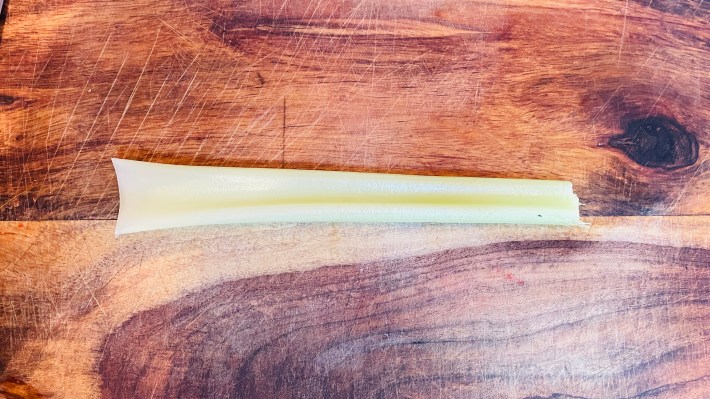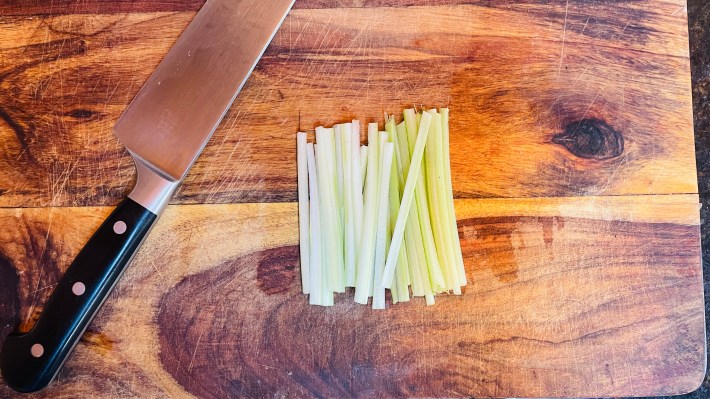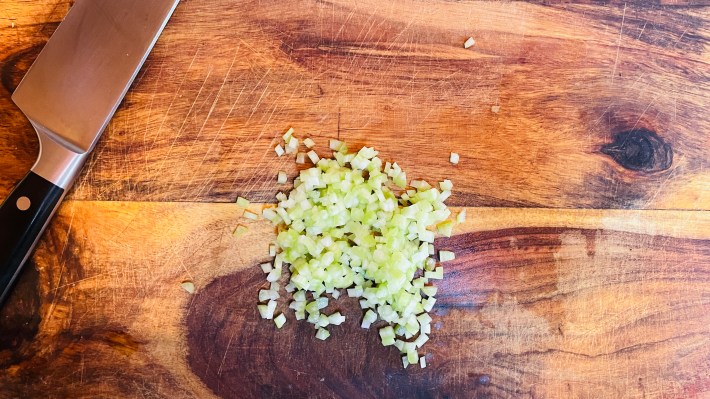Crab, at least where I live on the globe, is summer food; owing to the crabs' mating and spawning habits, summer is really the only time of year when you can catch and cook and eat them without doing terrible needless damage to the species' ability to maintain its population. But also, crabs are messy and give off powerful aromas that are very good at first and then quickly not, so the thing to do is to eat them outside, where neither the mess nor the scent can make the interior of your home look or smell like the inside of a crab-shack dumpster. Even in our blasted climate-change time this is still pretty impracticable in wintertime, for those of us living in the planet's Deciduous Belts.
Soup, on the other hand, and particularly in the case of (mildly) thickened and (moderately) creamy soup like the kind you're making today, is winter food. It makes you hot, and very full, and unless you are a villager in the Stone Soup fable you are not making soup outside in a cauldron over a fire but rather inside, in your kitchen, on your stove, where it will simmer for a while and warm up the inside of your house. If you do this in the summer then both you and your home will be too hot by the end of it.
This makes crab and soup awkward partners, at least logistically. Thankfully somebody invented pasteurization and canning. Otherwise you'd really be up shit creek, buddy. Instead, you're making crab soup, oh yes you are, right now.
Here are some things that you will need.
You will need some pasteurized crab meat, the kind that comes in tubs in the refrigerator or on ice at the grocery store or seafood market or whatever. Let's discuss that for a moment.
Packaged crab meat is divided into grades by criteria like what part of the crab's body it came out of, the size of the crab, the size of the pieces of crab meat in the tub, how many little pieces of shell you're likely to find in there with the meat, and so forth. In most places, "Jumbo Lump" is the fanciest grade you'll be able to find, consisting of big whole hunks of crab the size of the end of your thumb (there's an even higher grade, called Colossal, but odds are even a relatively fancy local supermarket won't have it). Crab soup with this stuff in it will be very exciting because it will feature discrete and satisfying bites of crab suspended in creamy broth, the way that, like, good beef stew will have well-formed individual hunks of carrot in it large enough to make for a spoonful all on their own. On the other hand, this stuff is not cheap: A one-pound tub can cost 60 bucks these days. If that is beyond your responsible grocery budget, I understand, because it is also beyond mine.
What you can do, then, is go down to the next grade, the stuff labeled simply "Lump," which will cost about 10 bucks less per pound-sized tub. The pieces in this tub will be less uniform; there will be, between them, lots of smaller shreds of crab meat. Odds are, crab soup made with this stuff will feature few, if any, big meaty bites of crab; on the other hand, there will be no spoonfuls of soup that do not have any substantial pieces of crab meat in them. There's a much greater probability that you will stumble across a few small and not super offensive shards of interior crab shell in your soup, unless you do the deeply insane work of tweezing these out of the one-pound mass of crab meat before adding it to the soup.
That's still 50 bucks for just one of the ingredients in a pot of dang soup! If that is offensive to you, or simply out of the question, I am very sorry. I can't in good conscience recommend going for the next grades down the scale, Backfin and Special, because at that point what you're going to get is kind of sad: a soup festooned with pathetic little white strings and too many shards of shell, featuring no satisfying bites of crab whatsoever, that would be no worse and even possibly better (for the lack of shells) if you replaced the crab with a can of tuna.
However! I can recommend, if you can find it, Claw-grade crab meat, which, as it sounds like, comes from the claws of the crab. It's cheaper than the above stuff, around 30 dollars a pound or less, because it comes in lil' bits, may include some pieces of shell, and likely will not feature any nice big hunks of meat—but it has a much stronger flavor than the other stuff, and will do better service to the overall flavor of your soup than even the Jumbo Lump variety. The trick there is that I can't find Claw-grade crab meat anywhere these days, even in the very crab-oriented state where I live. Maybe you will have better luck.
In any event what I do not recommend is settling for less than a pound of crab meat, if you're planning on making crab soup for, say, four or five reasonably enthusiastic people. At a certain point of diffusion into broth the name "crab soup" starts to feel like some kind of rude joke.
Whatever kind of crab you get, it likely came in a plastic tub; it's likely formed into a sort of firm molded shape in there. The thing to do is to very gently loosen and tease apart the individual hunks of crab, maybe even with your own vile fingers. This is particularly important if you went for the priciest stuff; it can very quickly become absurd for you to have spent the extra 10 or 20 bucks if the lumps all fall apart as you roughly separate them. OK, that's it for the crab! Let's move on now.
You'll need a couple quarts of some liquid. I mean it is, after all, soup. I defy you to make soup without liquid. You can't fuckin' do it! If you can get or make a couple quarts of fish or seafood stock (or fumet!), that will be great. If you can get or make a couple quarts of vegetable stock, that is also fine. If you can score a couple eight-ounce bottles of clam juice and supplement that with water, that'll work. I can't vouch for chicken stock, or plain tap water, or milk, or windshield wiper fluid. Oh hey and also, speaking of liquid, a couple cups of cheap wine will be great. This can be sweet wine, like sherry, or it can be dry white wine, according to your preference; if it's the former, the soup broth will be sweeter than if it's the latter, but it'll be fine in any case. And then also, on the subject of liquids, a glug or two of Worcestershire sauce and maybe a couple tablespoons of a tart, acidic food liquid of your choice, such as lemon juice or a relatively plain vinegar or Tabasco. One last liquid (I think): somewhere between half a cup and a cup of cream.
You'll need tomato paste. This can be the teeny lil' six-ounce can, or it can be the soup-can-sized 12-ounce can. The soup in that photo up there was made with 12 ounces of tomato paste, and it was good. You'll need a couple tablespoons of some cooking fat, like butter or olive oil or vegetable oil; if you are a Bacon Grease Zealot, suit yourself. I do not wish to fight with you over whether the cooking fat, in fact, counts as yet another liquid, and I won't damn do it. You'll need maybe a couple tablespoons of flour. You'll need a big yellow onion and a couple cloves of garlic. Dice these very finely if you don't want to use a blender later; if you're cool with smoothing out the broth later on with a blender (immersion or not), then you can be more slovenly with the dicing. In any event chop 'em up real good. You'll need a couple big stalks of celery, with the same chopping admonishments.
A good way to chop a stalk of celery into very small and uniform pieces, while we are on the subject, is to cut it in half, crosswise, then slice each half lengthwise into matchstick-thin strips, then line up all the strips and cut them crosswise into teeny tiny baby pieces. Like so:



You'll need some scallions, sliced into thin rings. You'll need a couple of bay leaves and some parsley; for the latter, pluck off the leaves and chop them very finely, and tie the de-leaved stems together with some kitchen twine. You'll need somewhere between a tea- and a tablespoon of Old Bay seasoning and either paprika or hot red cayenne powder or both. You'll need salt and pepper. You will need either some crackers (oyster or saltine, you decide) or some crusty bread. You will not need some corn, like the kind that comes frozen in a bag and you can sock the bag in the microwave for five minutes, but it will be good in your crab soup if you decide to get some. If you do decide to get some, nuke it according to the instructions, then drain it in a colander and set it aside.
I am not going to say that you need tinned or jarred anchovy fillets, mainly because I have had it up to here with being owned in the comments over including anchovies in everything. I will just say this: Owing to its delicate nature, and the fact that it was already cooked before it went in the plastic tub in the first place, the crab only goes into this soup at the very end of the procedure, just for long enough to get warmed up and fragrant before the soup goes into bowls. This means that the soup itself, the liquid around the crab, may not deliver a very satisfying seafood flavor, particularly if you do not have a rich, fresh seafood stock (or a lot of that clam juice) in the broth. If there were some kind of inexpensive, preserved—tinned, say!—and world-famously useful cooking ingredient that could multiply the seafoodiness of the soup while leaving virtually no tangible trace of itself behind, like it just miraculously melts into the cooking fat and deepens and intensifies everything that makes the soup good, it would be the wise home cook who made good use of this ingredient, and the shameful dunce who would not. Do with this invaluable sacred knowledge whatever you have the courage and vision and wisdom to do with it.
I'm reasonably confident that's all the ingredients. You'll need a big pot or Dutch oven, and a cooking implement, such as a wooden spoon or a flexible silicone spatula or your uncle's prosthetic arm. Let's cook.
Heat up the cooking fat in the pot on the stove over medium-high heat; when it's hot, dump in the onions and the celery, sprinkle them with salt, and kinda move them around with your implement for, oh, 10 or 15 minutes, enough time for them to sweat and soften some and for maybe some sticky onion residue to start accumulating on the cooking surface. Now chuck the garlic, paprika/red pepper, and any unnamed magical seafood ingredients you had the personal integrity and handsomeness to include in there and move things around; within a minute you'll be able to smell the garlic and paprika, and the miraculous heroic saint ingredient that shall not be named will have dissolved and left only its wonderful and indeed holy intercession of flavor behind for we who are not good enough to deserve it.
Now it's time to plop the tomato paste in there and stir and fold everything around with the implement until all that stuff is mixed together, you can smell a powerful hot tomato aroma, and there's even some tomato paste sticking to the bottom of the pot. Add the flour, stir and fold it into the pasty goo, and give it a minute to heat up. By now you should definitely have some gunk glued to the bottom of the pot. Pour in your cheap wine and use your implement to scrape up that gunk while the wine deglazes the cooking surface. When you're done you should have a smooth, homogenous and incredible-smelling brick-red goop, studded with aromatics. Likely it is bubbling. Let it cook for a minute or two, throwing in a stir every now and again, until the sharpness has come off of the wine fumes and you can smell the tomato again.
Next, stir in that cooking liquid, the seafood stock or vegetable stock or clam juice, a cup or two at a time, so that each pour gets fully stirred into what's in the pot before you add the next. Bring the pot up to a simmer, and lower the heat so it stays simmering. Taste the broth. Does it need salt? It probably needs salt. Don't add salt just yet. Add a teaspoon of the Old Bay seasoning, stir it in, and taste again. Probably the soup is not as direly in need of salt now, because Old Bay seasoning is salty as hell. If it's still bland, add a little more salt, stir, and taste again.
It's fine if the soup still falls on the bland side, right now; you can and maybe even should let it simmer for a little while, which will concentrate its flavors, and there's still the salty Worcestershire sauce to consider. On the flip side, if it already strikes you as too salty, it's fine to add some water to the pot, stir it in, taste, and add some more, until you've got the saltiness under control. You're not braising stew meat in there, so it's not like this stuff needs six hours of gentle simmering before you'll have more than a faint idea of what it's gonna taste like.
OK, so, once you've got the salt level more-or-less where you want it, toss in your bay leaves and that bundle of parsley stems, and grind some black pepper in there. Give everything a stir, let it return to a simmer if it departed from there, and give it, oh, half an hour to hang out at a low simmer, with maybe a desultory stir thrown in every few minutes.
Did a half-hour go by? I wouldn't know; I wrote this blog over a day ago. If a half-hour went by, taste your young soup. It's good! Extract the bay leaves and the parsley. Now it's choosing time.
Do you want to blend this stuff into a smooth, velvety broth, like the soup in the photo at the top of this blog? Then, uh, it will be necessary for you to do that, either with an immersion blender or by very carefully pulsing small amounts of soup one at a time in a standing blender (so as not to have the horrible exploding blender experience). On the other hand, if you do not give a damn about that, that is also fine. If you do not give a damn about blending the soup into a smooth, velvety broth, then simply do not do it. Make your choice! Act accordingly! I'll be waiting over here.
OK. You made your choice. Taste the soup again. Yum. You could eat it now as just, like, a tomato-y, gently seafood-y soup. Everything that's left to do amounts to finishing it, and also to turning it, at last, into crab soup. Raise the heat a tad, so the soup can maintain its warmth through the additions you're about to make. Stir in the cream. If you feel like the salt level can bear it, add the Worcestershire and any more Old Bay or salt or pepper that you think the soup needs. If you decided to nuke a bag of corn, stir that in. Gently (gently!) fold in the crab and all but a few pinches of the chopped parsley leaves.
What about the scallions? is what you are shrieking right now, shaking your fists at the sky, blind with rage and horror. What about the scallions????????? I'll tell you what about the scallions! It's fine, if you chopped a lot of scallions, to stir some of the whiter bits into the soup now and let them warm up briefly before you portion the soup out into bowls, so that you get a nice mild scallion flavor going in the soup. But also, please leave out some of the nice pretty green scallions for garnishing the top of each bowl of soup, along with the remaining parsley, for the sake of prettiness and aroma, two things that matter, dammit.
Oh right, speaking of that: Ladle the soup into bowls. Arrange a wee pinch of scallions and parsley atop each one. I never told you to heat up the crusty bread (if you got any) for six minutes in a 400-degree oven, but you should have done that, and now it's too damn late for both of us. If you didn't get bread, then set out a bowl of crackers for crumbling into the soup.
That's it. You made crab soup. It's hot and good and I'm confident you'll like it, and that it's your fault if you don't. Enjoy.






